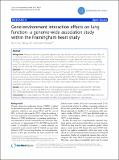| dc.contributor.author | Liao, Shu-Yi | en_US |
| dc.contributor.author | Lin, Xihong | en_US |
| dc.contributor.author | Christiani, David C | en_US |
| dc.date.accessioned | 2014-03-11T13:25:16Z | |
| dc.date.issued | 2013 | en_US |
| dc.identifier.citation | Liao, Shu-Yi, Xihong Lin, and David C Christiani. 2013. “Gene-environment interaction effects on lung function- a genome-wide association study within the Framingham heart study.” Environmental Health 12 (1): 101. doi:10.1186/1476-069X-12-101. http://dx.doi.org/10.1186/1476-069X-12-101. | en |
| dc.identifier.issn | 1476-069X | en |
| dc.identifier.uri | http://nrs.harvard.edu/urn-3:HUL.InstRepos:11879477 | |
| dc.description.abstract | Background: Previous studies in occupational exposure and lung function have focused only on the main effect of occupational exposure or genetics on lung function. Some disease-susceptible genes may be missed due to their low marginal effects, despite potential involvement in the disease process through interactions with the environment. Through comprehensive genome-wide gene-environment interaction studies, we can uncover these susceptibility genes. Our objective in this study was to explore gene by occupational exposure interaction effects on lung function using both the individual SNPs approach and the genetic network approach. Methods: The study population comprised the Offspring Cohort and the Third Generation from the Framingham Heart Study. We used forced expiratory volume in one second (FEV1) and ratio of FEV1 to forced vital capacity (FVC) as outcomes. Occupational exposures were classified using a population-specific job exposure matrix. We performed genome-wide gene-environment interaction analysis, using the Affymetrix 550 K mapping array for genotyping. A linear regression-based generalized estimating equation was applied to account for within-family relatedness. Network analysis was conducted using results from single-nucleotide polymorphism (SNP)-level analyses and from gene expression study results. Results: There were 4,785 participants in total. SNP-level analysis and network analysis identified SNP rs9931086 (Pinteraction =1.16 × 10-7) in gene SLC38A8, which may significantly modify the effects of occupational exposure on FEV1. Genes identified from the network analysis included CTLA-4, HDAC, and PPAR-alpha. Conclusions: Our study implies that SNP rs9931086 in SLC38A8 and genes CTLA-4, HDAC, and PPAR-alpha, which are related to inflammatory processes, may modify the effect of occupational exposure on lung function. | en |
| dc.language.iso | en_US | en |
| dc.publisher | BioMed Central | en |
| dc.relation.isversionof | doi:10.1186/1476-069X-12-101 | en |
| dc.relation.hasversion | http://www.ncbi.nlm.nih.gov/pmc/articles/PMC3882096/pdf/ | en |
| dash.license | LAA | en_US |
| dc.title | Gene-environment interaction effects on lung function- a genome-wide association study within the Framingham heart study | en |
| dc.type | Journal Article | en_US |
| dc.description.version | Version of Record | en |
| dc.relation.journal | Environmental Health | en |
| dash.depositing.author | Liao, Shu-Yi | en_US |
| dc.date.available | 2014-03-11T13:25:16Z | |
| dc.identifier.doi | 10.1186/1476-069X-12-101 | * |
| dash.contributor.affiliated | Liao, Shu-Yi | |
| dash.contributor.affiliated | Christiani, David | |
| dash.contributor.affiliated | Lin, Xihong | |


